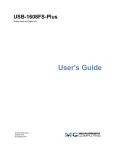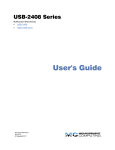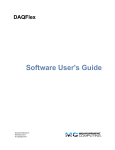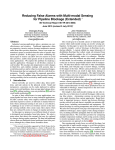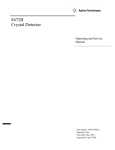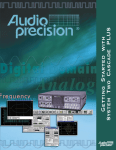Download USB-2001-TC User's Guide - from Measurement Computing
Transcript
USB-2001-TC USB-based Thermocouple Input User's Guide Document Revision 5 April 2012 © Copyright 2012 Your new Measurement Computing product comes with a fantastic extra — Management committed to your satisfaction! Thank you for choosing a Measurement Computing product—and congratulations! You own the finest, and you can now enjoy the protection of the most comprehensive warranties and unmatched phone tech support. It’s the embodiment of our mission: To provide data acquisition hardware and software that will save time and save money. Simple installations minimize the time between setting up your system and actually making measurements. We offer quick and simple access to outstanding live FREE technical support to help integrate MCC products into a DAQ system. Limited Lifetime Warranty: Most MCC products are covered by a limited lifetime warranty against defects in materials or workmanship for the life of the product, to the original purchaser, unless otherwise noted. Any products found to be defective in material or workmanship will be repaired, replaced with same or similar device, or refunded at MCC’s discretion. For specific information, please refer to the terms and conditions of sale. Harsh Environment Program: Any Measurement Computing product that is damaged due to misuse, or any reason, may be eligible for replacement with the same or similar device for 50% of the current list price. I/O boards face some harsh environments, some harsher than the boards are designed to withstand. Contact MCC to determine your product’s eligibility for this program. 30 Day Money-Back Guarantee: Any Measurement Computing Corporation product may be returned within 30 days of purchase for a full refund of the price paid for the product being returned. If you are not satisfied, or chose the wrong product by mistake, you do not have to keep it. These warranties are in lieu of all other warranties, expressed or implied, including any implied warranty of merchantability or fitness for a particular application. The remedies provided herein are the buyer’s sole and exclusive remedies. Neither Measurement Computing Corporation, nor its employees shall be liable for any direct or indirect, special, incidental or consequential damage arising from the use of its products, even if Measurement Computing Corporation has been notified in advance of the possibility of such damages. Trademark and Copyright Information Measurement Computing Corporation, InstaCal, Universal Library, and the Measurement Computing logo are either trademarks or registered trademarks of Measurement Computing Corporation. Refer to the Copyrights & Trademarks section on mccdaq.com/legal for more information about Measurement Computing trademarks. Other product and company names mentioned herein are trademarks or trade names of their respective companies. © 2012 Measurement Computing Corporation. All rights reserved. No part of this publication may be reproduced, stored in a retrieval system, or transmitted, in any form by any means, electronic, mechanical, by photocopying, recording, or otherwise without the prior written permission of Measurement Computing Corporation. Notice Measurement Computing Corporation does not authorize any Measurement Computing Corporation product for use in life support systems and/or devices without prior written consent from Measurement Computing Corporation. Life support devices/systems are devices or systems that, a) are intended for surgical implantation into the body, or b) support or sustain life and whose failure to perform can be reasonably expected to result in injury. Measurement Computing Corporation products are not designed with the components required, and are not subject to the testing required to ensure a level of reliability suitable for the treatment and diagnosis of people. HM USB-2001-TC.docx Table of Contents Preface About this User's Guide ....................................................................................................................... 4 What you will learn from this user's guide ......................................................................................................... 4 Conventions in this user's guide ......................................................................................................................... 4 Where to find more information ......................................................................................................................... 4 Chapter 1 Introducing the USB-2001-TC .............................................................................................................. 5 Functional block diagram ................................................................................................................................... 6 Chapter 2 Installing the USB-2001-TC .................................................................................................................. 7 What comes with your USB-2001-TC shipment? .............................................................................................. 7 Hardware .......................................................................................................................................................................... 7 Documentation .................................................................................................................................................................. 7 Unpacking the USB-2001-TC ............................................................................................................................ 7 Installing the software ........................................................................................................................................ 7 Installing the hardware ....................................................................................................................................... 7 Programming and developing applications ......................................................................................................... 8 Chapter 3 Functional Details ................................................................................................................................. 9 Components ........................................................................................................................................................ 9 Thermocouple input .......................................................................................................................................................... 9 USB connector .................................................................................................................................................................10 LED indicator ..................................................................................................................................................................10 Analog input circuitry ....................................................................................................................................... 10 Open-thermocouple detection (OTD) ..............................................................................................................................10 Thermocouple measurement accuracy.............................................................................................................. 11 Cold-junction temperature measurement accuracy ..........................................................................................................11 Mechanical drawings ........................................................................................................................................ 11 Chapter 4 Specifications ......................................................................................................................................12 Channel configurations ..................................................................................................................................... 12 Compatible thermocouples ............................................................................................................................... 13 Temperature accuracy....................................................................................................................................... 13 LED indicator ................................................................................................................................................... 16 Power ................................................................................................................................................................ 16 Safety voltages .................................................................................................................................................. 17 Bus interface ..................................................................................................................................................... 17 Mechanical ....................................................................................................................................................... 17 Environment ..................................................................................................................................................... 17 Declaration of Conformity ..................................................................................................................18 3 Preface About this User's Guide What you will learn from this user's guide This user's guide describes the Measurement Computing USB-2001-TC data acquisition device and lists device specifications. Conventions in this user's guide For more information Text presented in a box signifies additional information and helpful hints related to the subject matter you are reading. Caution! Shaded caution statements present information to help you avoid injuring yourself and others, damaging your hardware, or losing your data. bold text Bold text is used for the names of objects on a screen, such as buttons, text boxes, and check boxes. italic text Italic text is used for the names of manuals and help topic titles, and to emphasize a word or phrase. Where to find more information Additional information about the USB-2001-TC is available on our website at www.mccdaq.com. You can also contact Measurement Computing Corporation by phone, fax, or email with specific questions. Phone: 508-946-5100 and follow the instructions for reaching Tech Support Fax: 508-946-9500 to the attention of Tech Support Email: [email protected] 4 Chapter 1 Introducing the USB-2001-TC The USB-2001-TC is supported under the following operating systems: Microsoft Windows 7/Vista/XP (32-bit or 64-bit) Macintosh (32-bit or 64-bit) Linux (32-bit or 64-bit) The USB-2001-TC is a USB 2.0 full-speed device. It is designed for USB 2.0 ports, and was tested for full compatibility with both USB 1.1 and USB 2.0 ports. The USB-2001-TC provides one thermocouple input channel. Thermocouple types J, K, R, S, T, N, E, and B are supported. The thermocouple type is software programmable and stored on the device. A 20-bit ADC processes the data conversions. Thermocouple input ranges are ±73.125 mV (calibrated) and ±146.25 mV, (not calibrated). The ±146.25 mV range is used for open thermocouple detection. The device has an integrated cold junction compensation (CJC) sensor for thermocouple measurements. An open thermocouple detection feature lets you detect a broken thermocouple. The USB-2001-TC is a standalone plug-and-play module which draws power from the USB cable. No external power supply is required. The USB-2001-TC ships with DAQFlex software. All configurable options are software programmable. The device is fully software calibrated. Figure 1. USB-2001-TC 5 USB-2001-TC User's Guide Introducing the USB-2001-TC Functional block diagram USB-2001-TC functions are illustrated in the block diagram shown here. Figure 2. USB-2001-TC functional block diagram 6 Chapter 2 Installing the USB-2001-TC What comes with your USB-2001-TC shipment? As you unpack your USB-2001-TC, verify that the following components are included. Hardware USB-2001-TC Documentation DAQFlex TempVIEW Quick Start The DAQFlex TempVIEW quick start shows you how to use the USB-2001-TC with the TempVIEW out-ofthe-box sample program to quickly measure and display temperature measurements. DAQFlex Insert The DAQFlex insert lists the internet location where you can download DAQFlex software, documentation, and firmware loader utility, and the location where you can learn more about DAQFlex software. Unpacking the USB-2001-TC As with any electronic device, you should take care while handling to avoid damage from static electricity. Before removing the USB-2001-TC from its packaging, ground yourself using a wrist strap or touch either the computer chassis or other grounded object to eliminate any stored static charge. If any components are missing or damaged, notify Measurement Computing Corporation immediately by phone, fax, or e-mail: Phone: 508-946-5100 and follow the instructions for reaching Tech Support Fax: 508-946-9500 to the attention of Tech Support Email: [email protected] Installing the software The USB-2001-TC is supported by DAQFlex software. Install DAQFlex software to develop data acquisition applications that can be deployed across multiple operating systems and custom embedded systems. DAQFlex software for each supported operating system is available from the DAQFlex download page at www.mccdaq.com/DAQFlexDL. Refer to the DAQFlex Software User's Guide at www.mccdaq.com/pdfs/manuals/DAQFlex%20Software.pdf for instructions about how to install DAQFlex software. Installing the hardware Install the software before you install your device A driver needed to run the USB-2001-TC is installed when you install the software. Therefore, you need to install DAQFlex software before you install the hardware. To connect the USB-2001-TC to your system, connect a USB cable from the USB connector to either a USB port on the computer or to an external USB hub connected to the computer. No external power is required. If the LED turns off If the LED is on but then turns off, the computer has lost communication with the USB-2001-TC. To restore communication, disconnect the USB cable from the computer, and then reconnect it. This should restore communication, and the LED should turn on. 7 USB-2001-TC User's Guide Installing the USB-2001-TC Programming and developing applications You can program and develop applications for the USB-2001-TC using DAQFlex software. OEM users can create a custom driver for use with the message-based firmware to interface with the device. Refer to the DAQFlex Software User's Guide for information about DAQFlex software. Refer to the Message-based Firmware Specification for information about the message-based firmware. 8 Chapter 3 Functional Details Components The USB-2001-TC has the following components: Thermocouple input USB cable and connector LED indicator Thermocouple input You can connect one thermocouple to a standard thermocouple subminiature connector. Thermocouple types J, K, R, S, T, N, E, and B are supported. The thermocouple type you select will depend on your application needs. Review the temperature ranges and accuracies of each type to determine which thermocouple is best suited for the application. Connect the positive lead of the thermocouple to the TC+ terminal, and the negative lead of the thermocouple to the TC– terminal. Figure 3. TC input terminals If you are unsure which of the thermocouple leads is positive and which is negative, check the thermocouple documentation or the thermocouple wire spool. Figure 4. Connecting a thermocouple For best results, use insulated or ungrounded thermocouples when possible. If you need to increase the length of your thermocouple, use the same type of thermocouple wires to minimize the error introduced by thermal EMFs. Temperature measurement errors depend in part on the thermocouple type, the temperature being measured, the accuracy of the thermocouple, and the cold-junction temperature. Thermocouple with bare wire leads If your thermocouple has bare wire leads, you can purchase a screw terminal subminiature connector to use with the USB-2001-TC. These are available from a number of suppliers, such as Nanmac Corporation (www.nanmac.com). For the best accuracy, the subminiature connector type and thermocouple type should match. 9 USB-2001-TC User's Guide Functional Details Figure 5 shows the screw terminal connector wiring. Figure 5. Screw terminal connector wiring USB connector The USB connector provides +5 V power and communication. The voltage supplied through the USB connector is system-dependent, and may be less than 5 V. No external power supply is required. LED indicator The device LED indicates the communication status, and uses up to 5 mA of current. LED behavior Condition Specification On – steady green On – blinking green Off The device is powered and ready for operation. The device is powered, but not yet enumerated by the USB. The device is not powered or is in USB suspend. Analog input circuitry Figure 6 shows the analog input circuitry. The thermocouple channel passes through a differential filter and is sampled by a 20-bit analog-to-digital converter (ADC). Figure 6. Analog input circuitry Open-thermocouple detection (OTD) The USB-2001-TC is equipped with open-thermocouple detection. With OTD, any open-circuit condition at the thermocouple sensor is detected by the software. An open channel is detected by driving the input voltage to a positive value outside the range of the thermocouple output. The software recognizes this as an invalid reading and returns the value "OTD". During an open thermocouple condition, some invalid values may be returned before the open thermocouple is reported. Check the STATUS value before reading temperature values To ensure that valid temperature readings are returned, verify that the value of STATUS is READY before taking measurements. Invalid temperature readings may be returned if the STATUS value is BUSY or ERROR. A value of BUSY indicates that no new data is available. In this condition the same temperature value as previously read is returned until the STATUS value changes to READY. 10 USB-2001-TC User's Guide Functional Details Thermocouple measurement accuracy Cold-junction temperature measurement accuracy Heat from other nearby heat sources can cause errors in thermocouple measurements by heating up the terminals so that they are at a different temperature than the cold-junction compensation sensor used to measure the cold junction. Minimizing thermal gradients Thermocouple wire can be a significant source of thermal gradients if it conducts heat or cold directly to terminal junctions. To minimize these errors, follow these guidelines: Use small-gauge thermocouple wire. Smaller wire transfers less heat to or from the measuring junction. Avoid running thermocouple wires near hot or cold objects. Increasing the thermocouple length If you need to increase the length of your thermocouple, use wires made of the same conductive material to minimize the error introduced by thermal EMFs. Data linearization To convert data acquired from the USB-2001-TC to temperature values, the following calculations need to be performed: A/D calibration CJC correction Thermocouple linearization These calculations are performed by the DAQFlex API. Refer to the DAQFlex API source code for an example of how to perform these calculations. Mechanical drawings Figure 7. USB-2001-TC dimensions 11 Chapter 4 Specifications All specifications are subject to change without notice. Typical for 25 °C unless otherwise specified. Caution! Electromagnetic interference can adversely affect the measurement accuracy of this product. The input terminals of this device are not protected for electromagnetic interference. As a result, this device may experience reduced measurement accuracy or other temporary performance degradation when connected cables are routed in an environment with radiated or conducted radio frequency electromagnetic interference. To limit radiated emissions and to ensure that this device functions within specifications in its operational electromagnetic environment, take precautions when designing, selecting, and installing measurement probes and cables. Analog input Table 1. Input characteristics Parameter Conditions Specification Channel-to-USB ground Channel-to-USB ground One 20 bits ±73.125 mV, calibrated ±146.25 mV, not calibrated. Used for open thermocouple detection. ±30 V >145 dB Number of channels ADC resolution Input ranges Common-mode range Common-mode rejection ratio (0 to 60 Hz) Noise rejection Temperature measurement ranges Conversion time Input bandwidth Differential input impedance Input noise Open thermocouple bias voltage Cold-junction compensation sensor accuracy Cold-junction compensation sensor resolution Overvoltage protection 50/60 Hz >80 dB Works over temperature ranges defined by NIST (J, K, R, S, T, N, E, and B thermocouple types.) The E type has a maximum limit of 900 ºC. 250 ms 1 Hz 20 MΩ between isolated 3.3 V and ground 2 µVpp 3.3 V 1.25 °C maximum, 0.6 °C typical –3 dB 0 to 65 ºC 0.0625 °C typical 30 V max between TC+ and TC– Channel configurations Table 2. Channel configuration specifications Sensor category Conditions Specification Thermocouple (Note 2) J, K, S, R, B, E, T, or N One differential channel Note 1: Channel configuration information is stored in internal FLASH Program Memory on the microcontroller by the firmware whenever any item is modified. Modification is performed by commands issued over USB from an external application, and the configuration is non-volatile. Note 2: The factory default configuration is undefined ‘#’. 12 USB-2001-TC User's Guide Specifications Compatible thermocouples Table 3. Compatible sensor type specifications Parameter Thermocouple type Specification J: –210 °C to 1200 °C K: –270 °C to 1372 °C R: –50 °C to 1768 °C S: –50 °C to 1768 °C T: –270 °C to 400 °C N: –270 °C to 1300 °C E: –270 °C to 900 °C B: 0 °C to 1820 °C Temperature accuracy The following graphs show the errors for each thermocouple type when connected to the USB-2001-TC. The graphs display the maximum errors at 25 °C and over the full operating temperature range, and account for cold-junction compensation errors. The graphs were generated using thermocouples connected to subminiature connectors of the same type. The CJC sensor resolution is 0.0625 °C. This is the minimum value of the CJC step width. As such, the reading may result in a saw tooth curve rather than a square curve as the temperature inside the board changes. This is the expected behavior. 13 USB-2001-TC User's Guide Specifications Temperature error of J type thermocouple Temperature error of K type thermocouple Temperature error of R type thermocouple 14 USB-2001-TC User's Guide Specifications Temperature error of S type thermocouple Temperature error of N type thermocouple Temperature error of B type thermocouple 15 USB-2001-TC User's Guide Specifications Temperature error of T type thermocouple Temperature error of E type thermocouple LED indicator Table 4. LED behavior Condition Specification Steady green Blinking green Off The device is powered and ready for operation. The device is powered, but not yet enumerated by the USB. The device is not powered or is in USB suspend. Power Table 5. Power specifications Parameter Specification Current consumption from USB Suspend current Recommended warm-up time 150 mA maximum, 100 mA typical 2.5 mA maximum 15 minutes 16 USB-2001-TC User's Guide Specifications Safety voltages Connect only voltages that are within these limits. Table 6. Safety voltage specifications Parameter Conditions Specification Isolation Channel-to-earth ground +30 V maximum (Note 3) Note 3: Measurement Category I is for measurements performed on circuits not directly connected to the electrical distribution system referred to as MAINS voltage. MAINS is a hazardous live electrical supply system that powers equipment. This category is for measurements of voltages from specially protected secondary circuits. Such voltage measurements include signal levels, special equipment, limited-energy parts of equipment, circuits powered by regulated low-voltage sources, and electronics. Bus interface Table 7. Bus specifications Parameter Specification USB specification Device compatibility USB 2.0 Full-Speed USB 1.1, USB 2.0 Mechanical Table 8. Mechanical specifications Parameter Specification Dimensions 62.56 mm (L) x 38.10 mm (W) x 20.32 mm (H) 2.46 in. (L) x 1.50 in. (W) x 0.80 in. (H) 2 meters (6.5 feet) Approximately 116 g (4.1 oz) Cable Length Weight Environment Table 9. Environmental specifications Operating temperature range Storage temperature range Operating humidity Storage humidity Maximum altitude Pollution degree 0 to 55 ° C –40 to 85 ° C 10 to 90% non-condensing 5 to 95% RH, noncondensing 2,000 m (at 25 ºC ambient temperature) 2 Note 4: The USB-2001-TC is intended for indoor use only. 17 Declaration of Conformity Manufacturer: Address: Category: Measurement Computing Corporation 10 Commerce Way Suite 1008 Norton, MA 02766 USA Electrical equipment for measurement, control and laboratory use. Measurement Computing Corporation declares under sole responsibility that the product USB-2001-TC to which this declaration relates is in conformity with the relevant provisions of the following standards or other documents: EC EMC Directive 2004/108/EC: General Requirements, EN 61326-1:2006 (IEC 61326-1:2005). Emissions: EN 55011 (2007) / CISPR 11(2003): Radiated emissions: Group 1, Class A EN 55011 (2007) / CISPR 11(2003): Conducted emissions: Group 1, Class A Immunity: EN 61326-2-1:2006, Particular requirements for sensitive test and measurement equipment for EMC unprotected applications. IEC 61000-4-2 (2001): Electrostatic Discharge immunity. IEC 61000-4-3 (2002): Radiated Electromagnetic Field immunity. IEC 61000-4-4 (2004): Electric Fast Transient Burst Immunity. IEC 61000-4-5 (2001): Surge Immunity. IEC 61000-4-6 (2003): Radio Frequency Common Mode Immunity. IEC 61000-4-11 (2004): Voltage Interrupts. To maintain compliance to the standards of this declaration, the following conditions must be met. The host computer, peripheral equipment, power sources, and expansion hardware must be CE compliant. All I/O cables must be shielded, with the shields connected to ground. I/O cables must be less than 3 meters (9.75 feet) in length. The host computer must be properly grounded. Declaration of Conformity based on tests conducted by National Instruments Corporation, Austin, TX , 787593504 USA in November, 2009. We hereby declare that the equipment specified conforms to the above Directives and Standards. Carl Haapaoja, Director of Quality Assurance Measurement Computing Corporation 10 Commerce Way Suite 1008 Norton, Massachusetts 02766 (508) 946-5100 Fax: (508) 946-9500 E-mail: [email protected] www.mccdaq.com



















